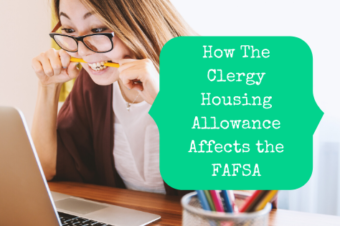

The following is an excerpt from my book, The Pastor’s Wallet Complete Guide to the Clergy Housing Allowance:
Calculating
By now you understand who is allowed to take a clergy housing allowance and the process by which you can do so. But here’s the big question everyone has: how do you know how much of a housing allowance to request?
First of all, there are limits to the amount of housing allowance that the IRS will allow you to claim. Your maximum allowed housing allowance is the least of:
- the amount actually used to provide or rent a home;
- the fair market rental value of the home (including furnishings, utilities, garage, etc.);
- the amount officially designated (in advance of payment) as a housing allowance; or
- an amount that represents reasonable pay for your services.
That means that even if your mortgage payment is $2,000 a month, if you could only rent the home (furnished, with utilities) for $1,500 your housing allowance has to be the lesser amount.
Remember that those services only include ministerial services. If you are a bi-vocational minister, you can only claim a housing allowance from your ministerial income. If your expenses can justify it, though, you could claim your entire ministerial income as a housing allowance and use your secular income for all of your other expenses. Also, it doesn’t matter how you are paid for your ministerial services. Whether it’s hourly or salary or by W-2 or 1099 does not affect the housing allowance.
To determine your housing allowance, you should calculate both your anticipated expenses and the fair market rental value of your home and request the lesser amount. When calculating anticipated expenses, it is wise to include an extra 10% or so to cover things that come up unexpectedly, like a new crib or repairing termite damage.
Some pastors regularly request the fair market rental value of their home even when it is higher than their anticipated expenses to ensure that they maximize the exclusion. The risk with this is that if your expenses are significantly lower, you will have to add the excess to your taxable income when you file your return and could end up owing a lot of taxes.
Also, retirement account contribution limits are often tied to income. Claiming a higher housing allowance reduces your taxable income and could unnecessarily limit the amount you can save for retirement in a tax-advantaged account. Usually, by the time you realize your taxable income will be higher (because you didn’t use the whole allowance), it’s too late to put more into retirement.
For families with children, the housing allowance can affect your child tax credit. Part of the child tax credit is refundable, which means the government will give you the money even if you don’t owe any taxes. However, the refundable portion is limited to a percentage of your income. If you erase too much income with the housing allowance, you could eliminate your refundable child tax credit and miss out on thousands of dollars. You’ll have to play with the numbers to find the right amount of housing allowance to claim to maximize all of the tax benefits available to you.
When calculating your expenses, make sure to include any large purchases that you have planned for the year, such as a new refrigerator or deck. If you live in a parsonage or other church-provided housing, only calculate those expenses that you, yourself, pay for. You can’t claim an exemption for something that the church is paying for. That’s lying, and we all know who the father of lies is. For a worksheet or online calculator to determine your housing expenses, visit https://pastorswallet.com/free-resources/.





8 Responses
Joe Wake
November 20, 2024Thank you for these great and helpful articles to help Pastors/Clergy navigate the nuances of their compensation. I have two questions for you regarding housing allowance and how it pertains to retirement contributions and FICA/SECA:
Question 1: Pastor makes $75k and designates $10k for housing allowance. The church offers a 403b retirement plan with a 5% (dollar for dollar) match. Which salary amount would be valid to use for contributing and match purposes?
Example 1: 5% of $75k = $3,750 employee contribution and $3,750 employer match. or…
Example 2: 5% of $65k (minus the housing amount) = $3,250 employee contribution and $3,250 employer match
Question 2: Some churches supply the “employer side” of FICA (7.65%) to the Pastor as income to help offset their total responsibility. In my example above what amount should the FICA offset be based on? The gross $75k or the net housing amount of $65k? I’m sure may be a matter of preference, but what best practices have you seen?
Thank you.
Amy
November 24, 2024Question 1: It would depend on the specific plan document’s definition of compensation, but I believe most churches include the housing allowance (Example 1) in their definition of compensation.
Question 2: The housing allowance is subject to SECA, so a true Social Security offset would include the housing allowance as compensation (Example 1).
Kelsie
January 23, 2025How would housing reimbursement work for an hourly pastor?
We just took on an assist pastor, he will work about 32 hours a week at $21/hr, he also designated $375 a week as his housing reimbursement. If we enter him in our payroll system as hourly at $21/hour and he clocks in, he will gross his time clocked and receive his housing on top of that. His hours will fluctuate so keeping him hourly is ideal. If we change his hourly amount lower to accommodate this it will be below minimum wage, how should we proceed?
Amy
January 26, 2025I’m sorry, but I am not familiar with payroll systems to know how to make this work. You could try reaching out to your payroll system provider, though they may not understand the housing allowance, or you could try asking this question in the Pastor’s Wallet Online Community on Facebook: https://www.facebook.com/groups/pastorswallet
Bob
February 17, 2025Are home living expenses for senior accommodation like grab bars, shower chair seats, toilet safety rails, bedside commodes, canes, and walkers covered by the clergy housing allowance?
Amy
February 21, 2025Bob, that’s a very good question. The IRS doesn’t address this specifically, but based on what I know of tax law, I would think that anything attached to the home, such as safety rails and grab bars would be eligible. Canes and walkers would be considered medical expenses, not housing expenses. Since the IRS doesn’t specifically address this, it will be your judgement call on what you claim and what you don’t.
Patrick
May 12, 2025How about streaming services like Sling Tv?
Amy
May 24, 2025The IRS has not specifically addressed streaming services, so it is up to your judgment. I personally view them the same as cable TV and would be comfortable counting it as an eligible expense.